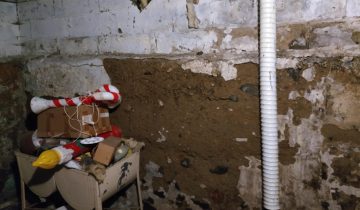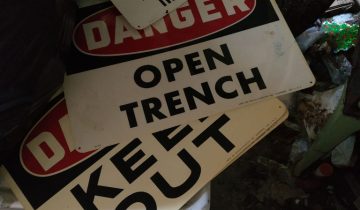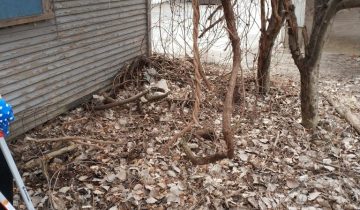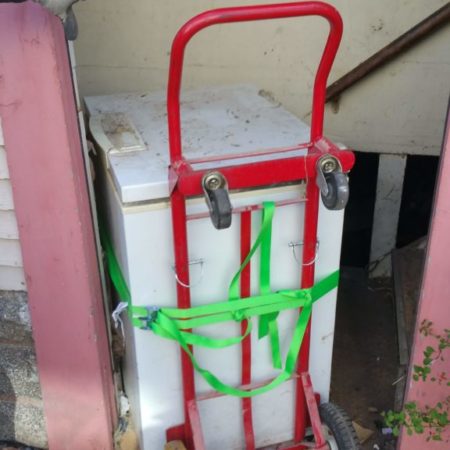The hoard is, through happenstance, winterized. That means we don’t have to worry about any pipes bursting or other systems failing throughout the winter, and one of the reasons I’m not hard-pressed to get back in there and turn on the heat.
Some of this was taken care of purposely back when the house was occupied, and some of it just happened because bills weren’t paid on time. Some of it we accidentally took care of during cleanup.
But, what does that even mean? How do you winterize a house? When should you do it?
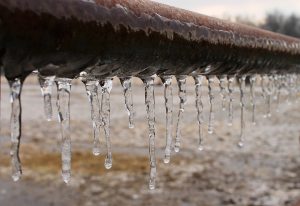
Winterization Protects Against Damage
The main idea behind winterizing a house is preventing the cold from doing any damage. While your house is occupied, you are using and observing the systems that could get hurt through disuse. However, if you are leaving your house for any length of time, you should turn down or disable systems that you don’t need running while you are away.
The biggest threat to a house in the winter is freezing water, which leads to burst pipes and wet basements. Some types of supplies are less susceptible to bursting, namely PEX, but they are only resistant for so long. So, water supply and drains are a consideration. You also don’t want to waste a lot of money in the long term. You’ll need to maintainin a proper temperature for your furnace or boiler.
In long-term winterization situations, electricity use should be looked at too, in terms of the safety of all plugged-in appliances. Combative to this, though, is security. You may still want it to appear that someone is home, or be able to check in on the place once in a while remotely. There is also the outside of the house, which should get a general checkup for winter regardless of whether you are leaving or not.
How long will you be gone?
If you are planning to be gone a week or two on vacation, then your winterization need not be too severe. If you’re one of those snow birds and fly south for the winter for several months, a different set of steps would be needed. Or, you might own property in a very cold location that you visit only infrequently, like a cabin up north. It’s best, then, to go whole hog and follow all recommendations to the max.
By the way, no matter which direction you go in Michigan, if you are headed away from a major city, you are headed ‘up north’. Fight me.
Short Term Winterization
These recommendations are for intervals of a few days up to a few months. It’s really at your discretion to how long you want to keep the heat and water on, but my personal breaking point is around a month. Any more and I would call that a long-term absence.
Heat
For most of us Michiganders, we have forced-air furnaces in our homes. If this is the case in your property, you should lower the temperature on the thermostat to around 50 degrees, which should be warm enough to prevent any pipes from freezing. Make sure that if this is your summer place, that you switch your thermostat from cool to heat. Otherwise when the temperature drops, it won’t be doing anything!
The rare hot water (or even steam) boiler application can get the same treatment, as can the equally rare heat pump installation, but only in cases where you aren’t disabling the system entirely.
Water
For vacations, not much needs to be done here other than make sure that the temperature of the pipes stays above freezing. In unheated areas where pipes are run, you may want to look at electrically heated pipe wrap tape, which keeps water lines just above freezing with a built-in thermostat.
Or, for long term applications or times when you just want to be really sure, the water can be shut off completely. We’ll cover this in a separate section a bit later.
The water heater is also part of your water supply system. A traditional tank heater will have a thermostat on it where you can adjust the maximum water temperature. Many have a ‘VAC’ or ‘Vacation’ setting which you can use when you don’t need to keep 40 gallons of hot water around on the off chance someone will need some. Tankless water heaters should need no adjustment for vacationers.
Drains will not be used during the winter, but traps and drains do maintain a small amount of water which needs to be evaluated. If you are leaving the heat on, this shouldn’t be bad at all, but if you are going long term, to the degree of turning off the water, there is more to do.
Electrical
Anything with a phantom draw, like TVs, stereos, computers, or phone chargers should be unplugged to save electricity while you are gone. You might even go so far as to disconnect everything except what’s absolutely necessary. The things you want to leave plugged in are your security system (if you have one), your sump pump, your fridge and freezer, and any lamps with timers that will be running in your absence. If you have a smart home and log in to check your cameras, or to randomly turn on lights, you will also need to leave your modem and router plugged in.
Other Considerations
If there is anything alive or perishable in your house, like cats, plants, or food, take them with you when you go, or make a plan for someone to care for them while you are away. It’s also a good idea to tidy up, vacuum, take out the trash, and put the dishes away. Nobody wants to come back to a dirty house.
Long Term Winterization
Heat
The heating system in your house should be disabled entirely to save money and preserve the system. Turn off your system at the thermostat, let the system power itself down, and then turn off the switch or breaker for your furnace. Gas powered furnaces should have their gas supply valve shut off, too.
If you use a water or steam boiler which you are disabling, the system should be drained. It might be cost effective to have your boiler installer come by and perform these steps for you; they will also be able to identify any areas where other water might be stuck. They may also have other recommendations; draining and refilling the system replaces the ‘dead’ de-oxygenated water in the system and introduces the opportunity for new oxidation.
If you decide against getting a pro’s recommendations, you can use these steps to drain your boiler. Turn off the water intake valve and let the system cool for an hour or two, then hook up a garden hose to the lowest drain valve and send the water to a sink or floor drain. If you have more than one drain on your system, make sure they all get opened up individually so that you can make sure there is no water left anywhere in the system, including the sight glass. Any steam traps will also need to have their test ports opened so that no water remains in them. Compressed air can be used to blow these out.
Heat pump and central AC owners should protect the heat pump from heavy snow or ice by placing a piece of plywood over the coils. This is so that if any ice sloughs off your roof, it won’t pierce the coil.
Water Supply
Our biggest threat is, again, burst pipes. Disable the system entirely to mitigate this threat as much as possible. This is a multi-step process that changes depending on the systems in your house, but I’ll try to be general:
- Locate your water meter. A proper installation has a valve on both sides of the meter, one ‘street-side’ towards the outside world, and one ‘house-side’ where the rest of your piping connects. Shut off the street-side valve first by turning it clockwise until it stops.
- Turn off the gas or electricity to your water heater, as well as your water softener or boiler, if you have one. Shut off the water supply to each of these appliances too. Leave the valve for hot water leaving the water heater open.
- Drain your water heater by connecting a garden hose to the tap at the bottom, then send the water to a drain or sink. Drain any other appliances that have water tanks the same way.
- Open the taps all around your house to let the system depressurize. This will let a bit more water out of the hot water heater. Flush your toilets a few times each to get as much water out as possible, including the reserve in the tank. Leave the taps open. This will let the water inside expand and contract just in case there is any left to freeze.
- If you have a house-side valve on your water meter, turn that off now. The best kinds of house-side valves have small drain ports that you can unscrew to let ALL the water out of your system. If you have one, open it now and have a bucket nearby to catch the output.
Water Drains
Now that the supply is done, we can do the drains. Any drain that has a trap, such as a sink or toilet, should get straight non-toxic antifreeze. This is NOT the same stuff that goes in your car! The label for your antifreeze should say ‘propylene glycol’ and not ‘ethylene glycol’. You can usually get it at RV supply stores or home centers.
- For sinks, bathtubs, or showers, add a cup or two of antifreeze right to the drain. For toilets, to make sure you get every part of the system, add antifreeze to the tank and then flush the toilet to replace what’s in the bowl.
- If your house has a dishwasher, it probably has a trap too. Disconnect the hose leading to your air gap or kitchen drain, and lower it to a bucket at floor level to drain as much water as possible. Then, add a third of a gallon of antifreeze inside your dishwasher tub and turn it on. You should hear the tub drain pump start working. Once it turns off, cancel the rest of the cycle.
- Activate your sump pump to drain out as much standing water as you can, but leave it plugged in to drain anything that shows up while you are gone. Your sump should have a one-way check valve just above it. This would keep water in the vertical drain line from returning to the sump. Add some antifreeze to your sump and activate it again for a few seconds to bring that mixed water into the drain.
Electrical
Anything you won’t be using while you’re away should be turned off at the breaker panel, including your stove, your dishwasher, your fridge, and your chest freezer. Make sure that you clean those out before you do, though, and leave the doors propped open. We don’t want a repeat from last time…
If you don’t have frostless models, unplugging the fridge or freezer will cause it to defrost, meaning all the ice inside will melt. You might want to do this a few days early so you can move the water it makes to the drain. Otherwise you might come back to a big dried up water spot under the freezer. Check your manual on how to properly usher the water away from the unit.
Anything you WILL want to use while you are away, such as your sump pump, timed lights, exterior motion lights, your security system, or your router and modem if you have smart things, will need to remain powered. Unplug other items on the same circuits as these appliances for safety.
Other Considerations
The gas supply in your house is hopefully at this point not feeding anything. Turn this off at the gas meter by giving the valve a quarter turn clockwise.
If you have mail delivered to your summer cabin and your mailbox does not have infinite size, you should contact the post office to stop or redirect your mail.
There are probably items outside of the house you need to check too. If you haven’t applied your storm windows, it can’t hurt now. Switch out those screens! If you haven’t done it last year, clean out your gutters and downspouts so that melting ice and snow will flow away from the house properly, and avoid ice dams in your roof.
And, with general winter maintenance, make sure there are no big branches hanging over your house that could fall in an ice storm and cause damage. Flex Tape probably can’t help you there.
Any house plants or other items that need regular attendance, like your children, should come with you when you leave. This includes other perishables, like that partially eaten loaf of bread or half of a box of cereal.
You might drop a note to your neighbors, if they are not also snow birds, to let them know you will be gone, and whether anyone will be coming to check up on the place. This will tip them off to call the police if there is any unauthorized activity at your house or cars in your driveway.
As before, tidy up, vacuum, and take out the trash. That certainly would put a damper on your relaxing return!
Dewinterizing
On your triumphant return, first check for any damage inside or out. We wouldn’t want to turn water on to a burst pipe. And, it would be good to know if a branch punched a hole in the roof or took down a wire before we turn on the heat.
There may also be issues with damage from there being no heat anyway. In our rental duplex, no heat for 7 years caused the paint on the walls and ceiling to curl up and fall off. I doubt this will be the case for a shorter interval like a year or less, but it’s worth mentioning.
Check also for any signs of critter intrusion. This could be broken basement windows, chewed holes in siding or soffits, messes in the pantry, and paw prints on the carpets. A dead raccoon in the cold air return makes a bad whole-house air freshener.
If it’s above freezing, turn on the water, and let the water heater and boiler fill up. Make sure that the taps you left open are all flowing (after they stop coughing air) and turn them off at the taps. Flush the toilet to replace the antifreeze. Enable the gas, power the furnace, and turn up the thermostat. Light the hot water heater too. If you have a water boiler, make sure the air in the system gets bled, and if you have a steam system, make sure the condensate traps that need priming are primed.
If it’s below freezing, turn on just the furnace first. Let it get going, and then turn on the water as above after the inside gets a bit warmer.
Turn on your electrical things and make sure the fridge is still working.
What has been done to the hoard?
Water was shut off by the city at the street for nonpayment some years ago. Shocking, I know. At that time, water slowly depressurized and the system got drained.
I’m not sure if it happened before or after, but the gas was also shut off. I remember that there was a campaign by the gas company to move meters outside of the house, and they had trouble getting hold of the old owner to let them in to repipe. Eventually it was moved outside, and promptly disabled. The meter is in fact completely gone.
Luckily, the father of the owner was a plumber, and knew that no water and no heat could break drains, so they were given the antifreeze treatment.
The electricity to the house was also turned off by the utility, so phantom power draws were entirely eliminated! But, the owner failed to clean out the fridge and freezer. We had to take care of that for them during cleanup.
I also took care of the trees overhanging the house in the fall, but this did not prevent water damage to the chimney causing a cave in in the closet. This could have just been age, though.
How will we de-winterize?
Very likely, all of the systems that should have been winterized will just be replaced. Not only have they been in an unknown state for some years, but they are also rather dated. Some, like the gas lines, are also mis-routed with the changes we want to make, such as removing the incinerator.
